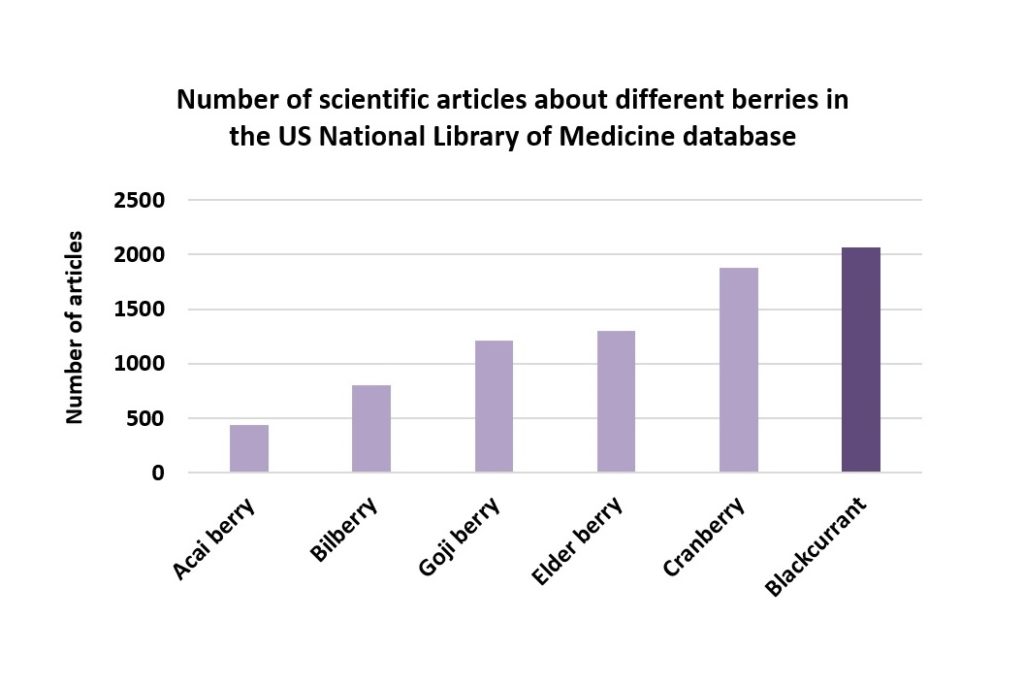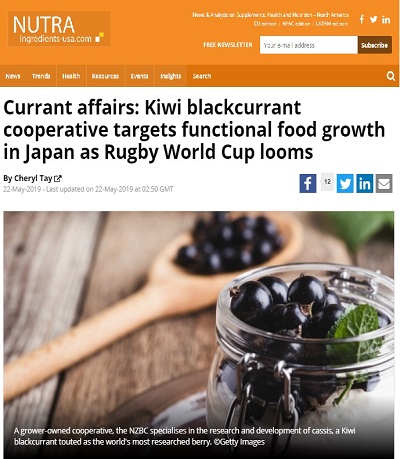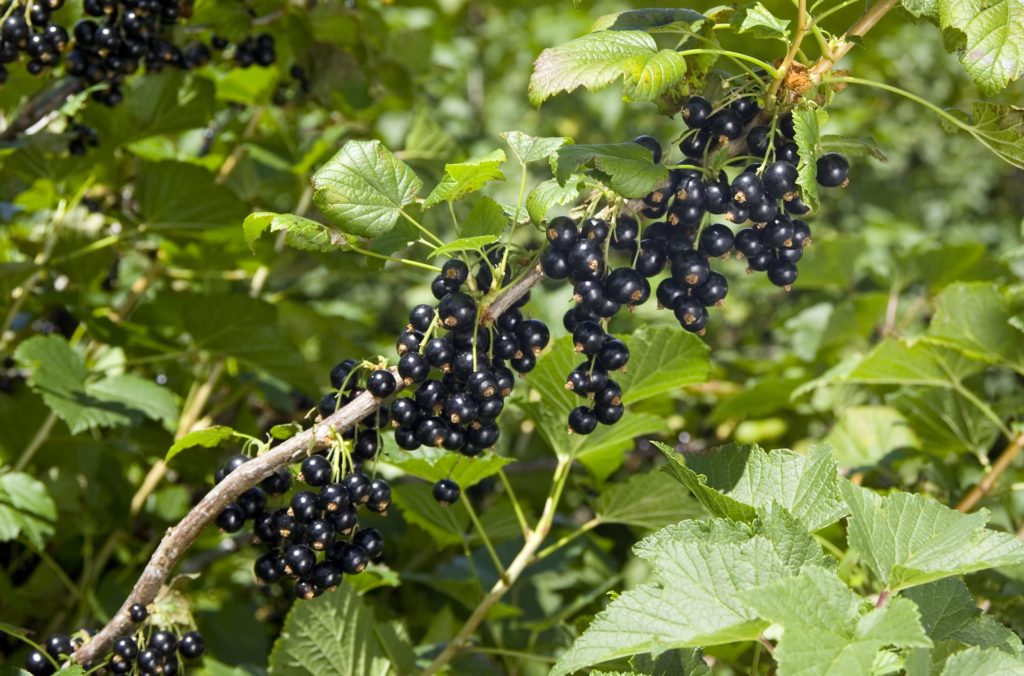Eyesight
New Zealand Cassis and Improved Vision
The human eye is constantly exposed to sunlight and artificial lighting. Exogenous sources of reactive oxygen species (ROS) such as UV light, visible light, ionizing radiation, chemotherapeutics, and environmental toxins, contribute to oxidative damage in ocular tissues. Long-term exposure to these insults places the aging eye at considerable risk for pathological consequences of oxidative stress. Furthermore, in eye tissues, mitochondria are an important endogenous source of ROS. Over time, all ocular structures, from the tear film to the retina, undergo oxidative stress, and therefore, the antioxidant defences of each tissue assume the role of a safeguard against degenerative ocular pathologies. The ocular surface and cornea protect the other ocular tissues and are significantly exposed to oxidative stress of environmental origin.
Overwhelming of antioxidant defences in these tissues clinically manifests as pathologies including pterygium, corneal dystrophies, and endothelial Fuchs dystrophy.
The crystalline lens is highly susceptible to oxidative damage in aging because its cells and their intracellular proteins are not turned over or replaced, thus providing the basis for cataract genesis. The trabecular meshwork, which is the anterior chamber tissue devoted to aqueous humour drainage, has a particular susceptibility to mitochondrial oxidative injury that affects its endothelium and leads to an intraocular pressure increase that marks the beginning of glaucoma. Photo-oxidative stress can cause acute or chronic retinal damage. The pathogenesis of age-related macular degeneration involves oxidative stress and death of the retinal pigment epithelium followed by death of the overlying photoreceptors. Accordingly, converging evidence indicates that mutagenic mechanisms of environmental and endogenous sources play a fundamental pathogenic role in degenerative eye diseases.
Vision Health Benefits of Blackcurrant Anthocyanins
- Effects of Blackcurrants on Visual Fatigue and Dark Adaption, VDT Work Induced Transient Refractive Alteration in Healthy Humans
*1
This was a randomised double-blind, placebo-controlled, cross-over study. Study size was 12 healthy adults for the dark adaption study, and subjects ingested up to 50 mg anthocyanins in capsules of New Zealand Cassis powder. Study size was 21 healthy adults for the transient refractive alteration study, and subjects ingested 50 mg anthocyanins as a juice for the transient refractive alteration test.- What was measured:
- Dark adaptation threshold
- Video display terminal (VDT) transient refractive alteration
- Visual fatigue (asthenopia)
- The results:
- Dark adaptation was significantly improved at the highest level of 540 mg Cassis powder (50 mg anthocyanin);
- Supplementation prevented myopic refractory shift after visual tasks on VDT’s: Comparing VDT transient refractive alteration, the refraction values for the dominant eye, BCA intake resulted in no decrease in the average value after the visual task; whereas, the placebo resulted in a large decrease in the average value, resulting in borderline significance (p = 0.064);
- Visual fatigue was significantly reduced with Cassis treatment.
- Lower back fatigue was significantly reduced with Cassis treatment.
- What was measured:
The effects are considered to be mediated by increased blood flow in the peripheral circulation.
- Stimulatory Effect of Cyanidin 3 Glycosides of the Regeneration of Rhodopsin
*2
In this study, the effect of the four anthocyanins in Cassis on the regeneration of rhodopsin was examined. Testing was conducted on frog rod outer segment (ROS) membranes. Three anthocyanins from Cassis stimulated regeneration of rhodopsin (a G-protein-coupled receptor localized in the retina of the eye), and formation of a regeneration intermediate was accelerated by cyanidin 3-rutinoside.- The results:
- Anthocyanin doses of 10-50uM were used in the tests. Overall, it was concluded that the major effect of anthocyanins in rod photoreceptors is on the regeneration of rhodopsin.
- The results:
- Delphinidin -3- Rutinoside Relaxes the Bovine Ciliary Smooth Muscle through Activation of ETB Receptor and NO/cGMP Pathway
*3
This in vitro study investigates the relaxation mechanism of D3R in bovine ciliary smooth muscle (CM), due to CM’s role in conditions such as myopia. D3R concentration of 105 M produced a sustained and progressive relaxation during the contraction induced by endothelia ET-1 in bovine specimens. The anthocyanin exerted an inhibitory effect on the ET-1 induced contraction with a concomitant increase in cyclic GMP production and decreased the phosphorylation ratio of myosin light chain.- The results:
- D3R possibly stimulated ET8 receptors to produce / release NO and resulted in an inhibition of myosin RLC phosphorylation and/or acceleration of dephosphorylation, thereby causing relaxation and producing an inhibitory effect on the ET-1 induced contraction on the bovine CM. The results of the study suggest that anthocyanin may be beneficial in improving myopia.
- The results:
- Purified High–dose Anthocyanoside Oligomer Administration Improves Nocturnal Vision and Clinical Symptoms in Myopia Subjects
*4
The aim of this study was to determine the effect of purified high dose anthocyanoside oligomer administration on nocturnal vision function and clinical symptoms in low-to- moderate myopia subjects. Sixty patients with asthenopia and refractive errors between -1.00 and -8.00 diopters in both eyes were used. Thirty were administered a purified high-dose anthocyanoside oligimer (100mg tablet compromising 85% anthocyanoside oligimer), and 30 were given a placebo twice daily for four weeks.- The results:
- Questionnaire data analysis showed that after conclusion of the treatment, 22 (77.3%) of the patients receiving anthocyanoside tablets showed improved symptoms. The results showed that the administration of anthocyanoside oligimer appears to improve subjective symptoms and objective contrast sensitivity in myopia subjects with asthenopia.
- The results:
- Comparative Assessment of Distribution of Blackcurrant Anthocyanins in Rabbit and Rat Ocular Tissues
*5
This study evaluated the ocular absorption, distribution, and elimination of Cassis anthocyanin in rats and rabbits after oral, intravenous, and intraperitoneal administration. Rats were given 100mg (oral) or 108mg (intraperitoneal) anthocyanin per kg of body weight and rabbits were given 20mg (intravenous) anthocyanin per kg of body weight.- The results:
- The results demonstrated that anthocyanins found in Cassis were absorbed and distributed in ocular tissues as intact forms, as they were found in plasma, ocular tissue (cornea, aqueous humor, iris, ciliary body, choroid, sclera, and retina), and the whole eye. It was also apparent that intact forms pass through the aqueous barrier and blood.
- The results:
- Anthocyanins and Anthocyanin-rich Extracts: Role in Diabetes and Eye Function
*6
This is a review article that summarizes various clinical trials about anthocyanins and vision of diabetics and non-diabetics. It is a comprehensive article that provides a better over-all understanding about anti- diabetic and eye function properties and the mechanism of anthocyanins. - Negative Lens-induced Ocular Growth in Chicks *7
This study evaluated the effects of orally administered Cassis extract on the enlargement of globe component dimensions induced in chicks by wearing negative lenses.
Negative lenses (–8 D) were worn on the right eyes by eight-day-old chicks, and their fellow eyes acted as controls. Cassis extract and distilled water (vehicle control) were both orally and intravenously administered once a day for three days. Dimensions of globe components of right eyes and fellow eyes were measured with an A-scan ultrasound instrument on the third day (day 4).- The results:
- Orally administered Cassis extract significantly inhibited enlargement of vitreous-chamber depth and axial and ocular lengths in a dose-dependent manner when compared to controls. Intravenously administered Cassis anthocyanins also inhibited elongation of vitreous-chamber depth and axial length when compared to controls.
- The results:
This is the first evidence that Cassis extract and Cassis anthocyanins could inhibit enlargement of globe component dimensions in a negative lens-induced chick myopia model.
- Effects of New Zealand Cassis on Glaucoma
Four clinical trials showed a positive effect on the disease of the eye called glaucoma. Glaucoma is a disease of the major nerve of vision, called the optic nerve. Glaucoma is a major cause of visual field defects and blindness.- Effects of anthocyanins in black currant on retinal blood flow circulation of patients with normal tension glaucoma, a pilot study *8
This study examined the effects of anthocyanins in Cassis on retinal blood flow circulation of patients with normal tension glaucoma.
Glaucoma is usually associated with high intraocular (eye) pressure. In normal tension glaucoma, the intraocular pressure is normal. In this study, thirty patients with normal tension glaucoma consumed Cassis anthocyanins (50mg) in tablet form once per day for six months.- At the end of the six month period:
- The subjects showed significantly increased blood flow at the neuroretinal rim of the optic nerve head and peripapillary retina.
- No significant changes in blood pressure or intraocular pressure were measured.
- None of the subjects showed progression of their visual field defects.
- The results:
- This study suggests that orally administrated anthocyanins may be a valuable neuroprotective treatment of patients with Normal Tension Glaucoma.
- At the end of the six month period:
- Two-year Randomized, Placebo Controlled Study of Blackcurrant Anthocyanins on Visual Field in Glaucoma *9
This study was a two-year randomised, placebo controlled study of Cassis anthocyanins on visual field in Glaucoma.
Blood flow to the retina and optic disk is thought to be an important factor in the cause of Open Angle Glaucoma. The study was a randomized, placebo-controlled, double masked trial looking at 38 patients with Open Angle Glaucoma, treated by anti-glaucoma drops. For two years, the subjects consumed 50mg per day of Cassis anthocyanins or a placebo.- The study shows two significant outcomes:
- The study measured visual field mean deviation to show changes in the visual field of subjects over time. The results showed that the placebo group had statically significant visual field mean deviation from the baseline. However, the group taking Cassis anthocyanins showed no significant changes in visual field mean deviation over the two year period.
- The study also measured ocular blood circulation. Ocular blood flow in the group taking the Cassis anthocyanins showed a statistically significant increase in comparison with the group taking the placebo. The placebo group showed no change in ocular blood flow over the two year period.
- The results:
- The study concluded that the oral administration of Cassis anthocyanins may be a safe and promising supplement for patients with Open Angle Glaucoma in addition to anti-glaucoma medication.
- The study shows two significant outcomes:
- Effects of Blackcurrant Anthocyanins on Intraocular Pressure in Healthy Volunteers and Patients with Glaucoma *10
This study examined the effects of Cassis anthocyanins on intraocular pressure in healthy volunteers and patients with Glaucoma.
Elevated intraocular pressure (IOP) is generally recognised as the most important risk factor for glaucoma.
This study was carried out to determine the effects of Cassis anthocyanins on intraocular pressure (IOP) in both healthy subjects and patients with glaucoma.- Two groups of subjects took part:
- Group 1. Cassis anthocyanins (50mg/day) or placebos were taken orally by 12 healthy subjects once daily for four weeks.
- Group 2. A total of 21 glaucoma patients (Cassis anthocyanins, n = 12; placebo, n = 9) treated with a single anti-glaucoma medication, who had participated in a previous study (see summary of study 2 above – Ophthalmologica 2012; 228:26–35) were selected and analysed. Systemic blood pressure, pulse rates, IOP, and Humphrey visual-field mean deviation (MD) were evaluated.
- The results:
- A statistically significant decrease in the mean IOP was observed at two weeks and four weeks from the baseline in Cassis anthocyanin-treated healthy subjects. However, this decrease was not observed in the placebo group.
- The results showed statistically significant decreases in mean IOP in the glaucoma patients taking Cassis anthocyanins compared to the placebo group.
- In addition, mean changes of visual field MD deterioration were significantly less in the anthocyanin-treated glaucoma patients administered with Cassis anthocyanins at 12 months and 18 months after the baseline.
- No clinically significant changes were observed in systemic blood pressure or pulse rates in either trial.
- These results suggest that oral administration of Cassis anthocyanins may induce a beneficial decrease in IOP levels in healthy subjects as well as in patients with glaucoma.
- Two groups of subjects took part:
- Blackcurrant Anthocyanins Normalized Abnormal Levels of Serum Concentrations of Endothelin – 1 in Patients with Glaucoma *11
This study examined how Cassis anthocyanins normalized abnormal Levels of serum concentrations of endothelin – 1 in patients with glaucoma.
A study of Cassis anthocyanins and glaucoma (see summary of study 2 above, Ophthalmologica 2012;228:26–35), which involved a 24-month trial, revealed that oral administration of Cassis anthocyanins slowed down the visual field deterioration and elevation of ocular blood flow of open-angle glaucoma (OAG).
To discover the underlying mechanisms of these Cassis anthocyanin-induced effects, changes of serum biomarker endothelin-1 (ET-1), were examined in the present study using 38 patients with Open Angle Glaucoma. Blood serum specimens were obtained from Cassis anthocyanin-treated (n = 19) or placebo-treated (n = 19) glaucoma patients at baseline and then every six months over 24 months. Healthy volunteers (n = 20) matching the age and gender of the glaucoma patients were used as a control.
ET-1 has been shown to be implicated in several ocular diseases including glaucoma. At the trial baseline, serum ET-1 concentrations were significantly lower in patients with OAG than those of the healthy volunteers.
Upon administration of Cassis anthocyanins, serum ET-1 concentrations increased to the levels of those in healthy volunteers during the 24-month period. In contrast, those of placebo-glaucoma patients remained at lower levels.- The results:
- This study concludes that among the possible beneficial effects of Cassis anthocyanins towards visual field progression, that Cassis anthocyanins caused normalisation of serum ET-1 which may improve ET-1 dependent regulation of ocular blood circulation.
- The results:
- Effects of anthocyanins in black currant on retinal blood flow circulation of patients with normal tension glaucoma, a pilot study *8
References
*1: Nakaishi, H., Matsumoto, H., Tominaga,S., Hirayama, M. Effects of blackcurrant anthocyanoside intake on dark adaptation and VDT work induced transient refractive alteration in healthy humans. ALTERNATIVE MEDICINE REVIEW 2000, 5: 553-562
*2: Matsumoto H, Nakamura Y, Tachibanaki S, Kawamura S, Hirayama M. Stimulatory effect of cyanidin 3-glycosides on the regeneration of rhodopsin.J Agric Food Chem. 2003; 51(12):3560–3563.
*3: Matsumoto, H (2005). Delphinidin-3-rutinoside relaxes the bovine ciliary smooth muscle through activation of ETB receptor and NO/cGMP pathway. Experimental Eye Research. 80:313-322.
*4: Lee, J. Purified high-dose anthocyanoside oligomer administration improves nocturnal vision and clinical symptoms in myopia subjects, British Journal of Nutrition (2005), 93, 895–899.
*5: Matsumoto. H (2006). Comparative assessment of distribution of blackcurrant anthocyanins in rabbit and rat ocular tissues. Experimental Eye Research. 83: 348-356.
*6: Ghosh D, Konishi T (2007). Anthocyanins and Anthocyanin-Rich Extracts: Role in Diabetes and Eye Function, Asia Pacific Journal of Clinical Nutrition 16:200 – 208.
*7: Lida H (2010). Effect of blackcurrant extract on negative lens-induced ocular growth in chicks, 2010, 44(4): 242-250.
*8: Ikuyo Ohguroll, Hiroshi Ohgurol, Mitsuru Nakazawa. Effects of anthocyanins in black currant on retinal blood flow circulation of atients with normal tension glaucoma, a pilot study. Hirosaki Medical ]ournal, 2007, 59: 23-32.
*9: Hiroshi Ohguru, Ikuyo Ohguro, Maki Katai, Sachie Tanaka , Two-year Randomized, Placebo Controlled Study of Blackcurrant Anthocyanins on Visual Field in Glaucoma. Ophthalmologica 2012, 228:26-35.
*10: Hiroshi Ohguru, Ikuyo Ohguro, Saeko Yagi. Effects of Blackcurrant Anthocyanins on Intraocular Pressure in Healthy Volunteers and Patients with Glaucoma. Journal of Ocular Pharmacology and Therapeutics 2013, Vol 29 No.1:61-67.
*11: Kaori Yoshida, Ikuyo Ohguro, Hiroshi Ohguru, Blackcurrant Anthocyanins Normalized Abnormal Levels of Serum Concentrations of Endothelin – 1 in Patients with Glaucoma. Journal of Ocular Pharmacology and Therapeutics 2013, Vol 29, No. 5:480-487










